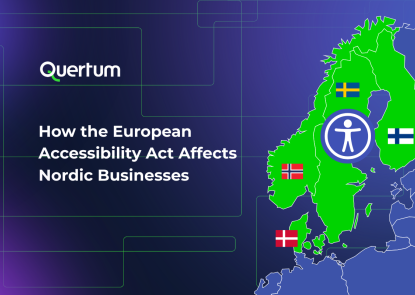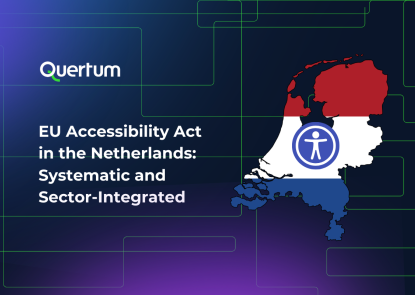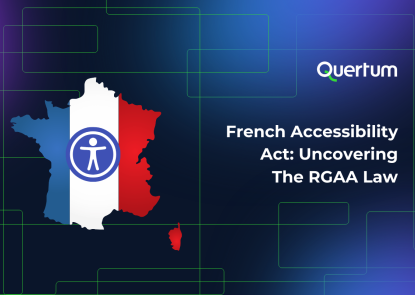EAA i dostępne dokumenty: O czym firma musi wiedzieć
wrzesień 12, 2025
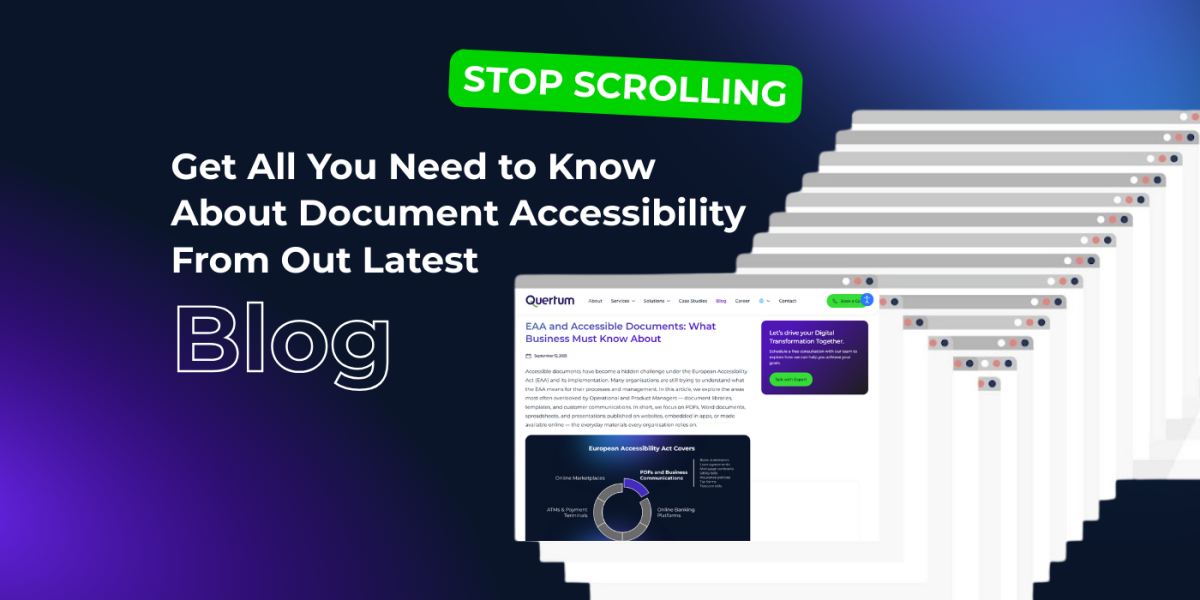
Accessible documents have become a hidden challenge under the European Accessibility Act (EAA) and its implementation. Many organisations are still trying to understand what the EAA means for their processes and management. In this article, we explore the areas most often overlooked by Operational and Product Managers — document libraries, templates, and customer communications. In short, we focus on PDFs, Word documents, spreadsheets, and presentations published on websites, embedded in apps, or made available online — the everyday materials every organisation relies on.
For banking, financial structures, insurance, utility firms or public sector companies the EU Accessibility Act isn’t just another compliance hurdle to jump over. The EAA represents a fundamental shift in how we think about digital communications and user access. Understanding these changes now will save you significant headaches (and budget) down the road.
Read our full guide and discover:
- How business communications became the new frontier of the European Accessibility Act;
- Co EAA rules apply to documents and communications in Germany, France, Poland, the Netherlands, and the Nordics;
- How to protect your budget by remediating document templates instead of fixing files one-by-one;
- Practical steps to future-proof your Document Management Systems (DMS/CCM) for accessibility;
- Why accessibility isn’t just compliance — but also efficiency, market reach, and brand strength.
Clearing Up the European Accessibility Act for PDFs and Documents
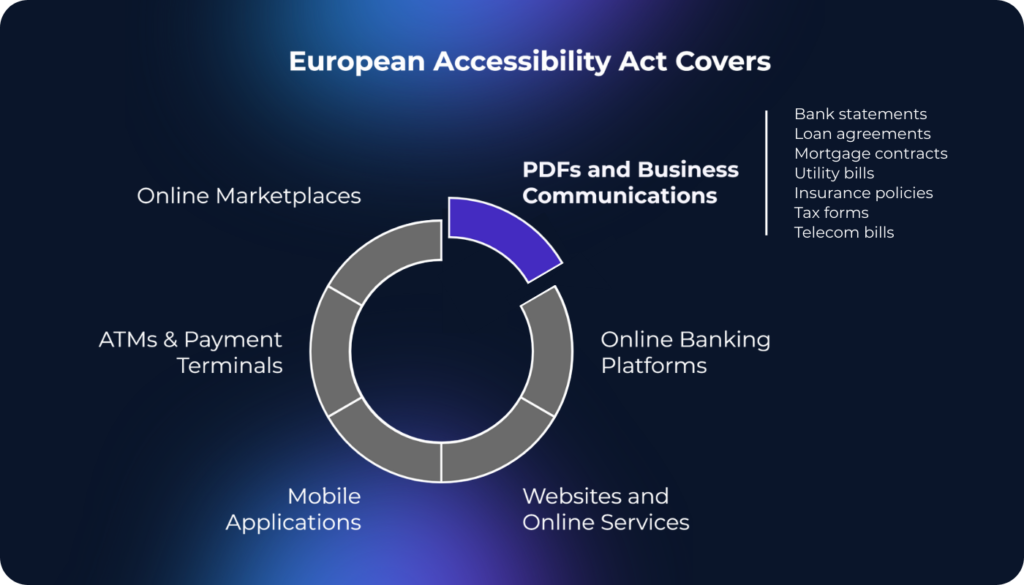
The most common question we hear is: “Does the EAA actually cover documents, or just websites and apps?” Documents are absolutely must comply with European Accessibility Act, especially when they’re part of digital services and offer a constant communication bridge between business and the client. Perfect example is a bank – PDF statement – client.
The EAA aligns with POUR accessibility guidelines to ensure digital content is Perceivable, Operable, Understandable, and Robust. Organisations must follow standards like WCAG 2.1 AA for web/mobile content and PDF/UA (PDF/Universal Accessibility) for electronic documents and PDFs to fully comply with EU Accessibility Act. WCAG (Web Content Accessibility Guidelines) covers websites, HTML emails, and other web content, while PDF/UA is the ISO standard for making PDF documents readable via assistive technology.
Key Requirements for Accessible Documents and PDFs
- Alternative text for images (so screen readers can describe images)
- Correct document subject, author, keywords for search and indexing.
- A logical reading order and navigability (using headings, bookmarks, and links for easy navigation)
- Sufficient kontrast kolorów, minimum 4.5:1 contrast ratio for normal text.
- Proper labeling of form fields for keyboard use, and general compatibility with assistive tech like screen readers and adaptive keyboards.
- And many more.
We’ve turned the core accessibility rules into a clear 1-page infographic, which you can share with your team and use to start you accessible business communication journey. Download the PDF Accessibility Infographic here:
In short, digital documents must be properly structured for screen reader compatibility and clear navigation to be accessible for people with impairments.
Think about your customer journey as an EAA auditor: loan applications, insurance policies, investment statements, regulatory disclosures. These aren’t just accessible documents, but the integral parts of your digital service delivery.
When a customer downloads their policy document from your portal, that PDF needs to meet the same accessibility standards as your website, to make the whole communication “omniaccessible”. This creates a ripple effect throughout your organisation. Your Document Management Systems, client portals, and digital workflows all need to ensure accessibility compliance.
“When we talk about accessibility, we’re not just talking about websites. Every document our customers download — whether it’s a loan offer, an insurance policy, or an investment report — is part of their digital experience with us. If it’s not accessible, we’re not truly inclusive.”
– Says Maciej Majewski, a CEO at Quertum
Accessible Documents and Business Communications in Germany, France, Poland, the Netherlands and Nordics Region
Here’s where things get interesting and slightly complicated. The EAA is a directive, which means each EU country implements it through their own national legislation. This creates variations that matter for your compliance strategy – both for documents, applications, website and offline accessibility.
The EAA’s enforcement framework mirrors the EU’s existing product safety regime, but with adaptations for services. There is no centralised EU “accessibility police”; instead, each Member State has designated one or more national authorities to monitor and enforce compliance within their jurisdiction.
Click on your country to learn more about local EAA regulations, and how to adapt your communications for operating on the region.
Niemcy: German implementation puts significant focus on financial services accessibility. BaFin has been particularly clear about expectations for customer-facing documents. If you’re serving German customers, your loan agreements and insurance policies are under enhanced scrutiny.
Francja: French regulations emphasize public service accessibility, with strict requirements for any documents that interface with government processes. Private companies with public contracts face additional oversight.
Polska: Polish implementation includes specific provisions for fintech and digital financial services, reflecting the country’s growing role as a regional fintech hub. KNF (the Polish Financial Supervision Authority) and government accessibility offices are expected to audit customer-facing statements, onboarding documents, and regulatory disclosures.
The Netherlands: Dutch enforcement builds on the existing WCAG-based accessibility law that already applies to public sector websites and documents. The focus is on harmonisation — ensuring that both government and private contractors deliver accessible PDFs, invoices, and digital communications. Enterprises bidding for public contracts must demonstrate full compliance in their document workflows.
Nordics Region: Sweden, Denmark, Finland, and Norway already have long-standing accessibility cultures, often going beyond EU minimums. National agencies place strong emphasis on public procurement and utilities. For example, banking and telecom statements are under scrutiny to ensure accessible billing. Nordic regulators are likely to enforce consistently and demand proof of accessibility at the template level, not just on websites.
The practical takeaway? If you operate across multiple EU markets, you’ll want to meet the highest standard across all jurisdictions. It’s more efficient than trying to manage different compliance levels for different countries.
Accessible Documents for Enterprises: Business Communications Within CCM and DMS
Enterprise Document Management and Customer Communications Management (CCM) systems have traditionally prioritised efficiency, security, and version control. However, with (European Accessibility Act, EAA) coming into force, dostępność cyfrowa has become a compliance “wild card” that organisations can no longer ignore.
The EAA introduces new requirements that affect:
- Document Creation Workflows: Every template, automated generation process and approval workflow needs accessibility checkpoints built in.
- Search and Retrieval: Users with disabilities must be able to find and access documents as efficiently as anyone else. This affects your search algorithms, metadata standards, and user interface design.
- Version Control: When documents are updated, accessibility features must be maintained and improved, not accidentally removed.
- System Integration: APIs, third-party connections, and data export functions must preserve accessibility across all touchpoints.
The good news is that most leading DMS/CCM platforms like Quadient Inspire, OpenText or Smart Communications have evolved to support accessibility features. The best practice is to incorporate accessibility at the template and content design stage, rather than fixing documents after the fact.
For example, Quadient Inspire – a leading CCM platform – has introduced robust features to help enterprises meet accessibility requirements. Inspire’s design tools allow template creators to define document structure (headings, reading order, etc.), text alternatives, and other tags so that the output PDFs are compliant with PDF/UA and the output emails or web content meet WCAG standards.
Quadient confirms that its Inspire portfolio can create accessible documents and emails when used properly, and it encourages organisations to bake accessibility into the design phase of communications. This means a bank using Inspire to generate monthly statements can configure templates such that each PDF statement comes out tagged and accessible by default, minimising the need for later fixes.
The silver lining? Addressing these challenges often improves overall system performance and user experience for everyone.
How to Check Your PDFs for Accessibility
The million-dollar question: “How do we assess our current documents for accessibility compliance?” And we’ve got you covered.
Again we recommend you to check our latest material about PDF Accessibility lub Download our Beginner Guide, which will lead you through the complete process of checking, remediation and creation of accessible PDF.
EAA Prediction: What Business Should Expect Next?
Since we’re now past the official EAA implementation date, enforcement is becoming increasingly active. Companies that haven’t addressed compliance face potential penalties and market access restrictions. More importantly, non-compliant businesses may find themselves excluded from public procurement opportunities. Here’s what regulated industries can expect in the coming years:
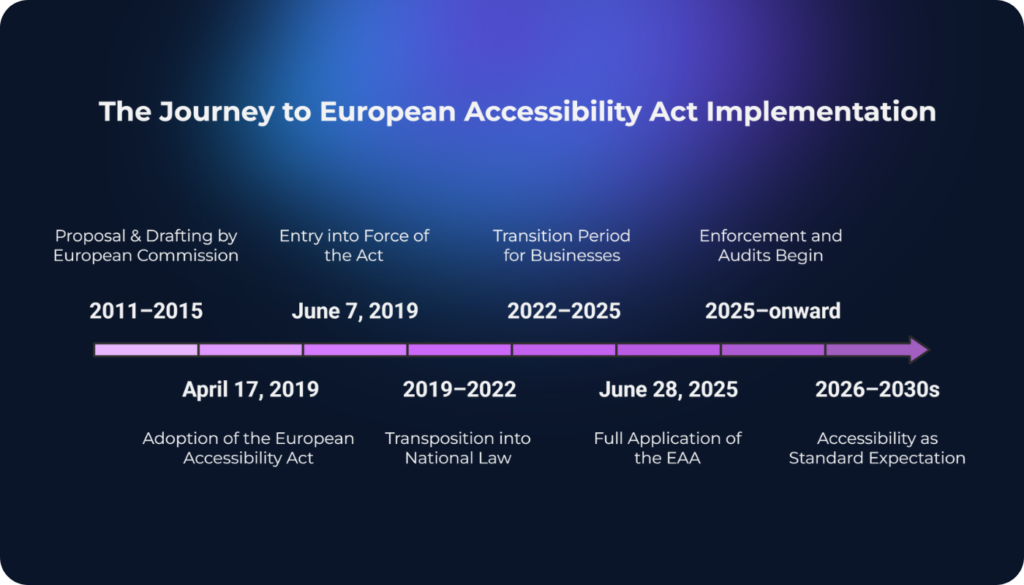
2025-2026: The Enforcement Ramp-Up
Regulatory audits may begin, particularly in sectors like finance and telecom where the impact of inaccessibility is highest. National authorities are issuing formal warnings and corrective action orders to organisations with non-compliant digital services. User complaint mechanisms are fully operational, meaning individual users and advocacy groups can trigger investigations.
The key shift is that regulators now require documented evidence of progress, not just promises to fix issues eventually. Your business communications, PDFs, and digital portals need to show measurable compliance improvements. In 2026 The first financial penalties are likely to be imposed — particularly on providers who failed to act on earlier warnings.
2027-2029: Market Maturity, Procurement Shifts, and Sector-Wide Compliance Pressure
Accessibility becomes a standard procurement requirement in public tenders and B2B agreements. Public sector buyers, utilities, and large enterprises will increasingly demand EAA-aligned compliance from their vendors and technology partners.
We expect to see industry-wide benchmarking: banks and telecoms will be compared based on accessibility, and those lagging behind may lose competitive ground or face reputational risk. Accessibility will factor into ESG metrics, investor reporting, and even board-level audits — especially in regulated sectors under public scrutiny.
2030: Legacy System Phase-Out
The final enforcement milestone requires all legacy equipment and digital touchpoints to meet current accessibility standards, regardless of when they were introduced.
The Strategic Opportunity Hidden in Compliance Requirements
EAA compliance may seem like just another regulatory task, but accessible documents can streamline operations, lower risks, and build stronger customer relationships. The companies that treat it as “just a tick” usually end up firefighting — retrofitting fixes, patching templates, and paying twice when audits catch what was missed.
The companies that bake accessibility into their document workflows discover something different: efficiency, market reach, and even stronger positioning in tenders.
Here’s what that looks like in the real world:
1. Expanded Market Reach = More Customers Served
Your website may already be compliant. But if a policy document, billing statement, or loan agreement is inaccessible, a customer with low vision or using a screen reader is left out.
Aging customers & people with disabilities benefit from well-tagged, accessible PDFs. For a bank, that could mean tens of thousands of customers able to independently read their monthly statements without calling the hotline.
2. Operational Efficiency = Fewer Support Tickets
Think about the cost of all the “I can’t open my bill” or “this form won’t let me type” calls. Those support requests don’t just frustrate customers, they drain service teams. Well-structured, accessible documents reduce these pain points. Templates that follow standards are easier
- to process with automation;
- for customers to navigate;
- for staff to update.
3. Stronger Brand Positioning = Competitive Edge
Procurement processes are already asking about accessibility. A utilities company bidding for a public contract that can prove its PDFs meet EAA standards has a measurable advantage over a competitor who can’t. Accessibility is a visible signal that you take inclusion and regulatory maturity seriously. That resonates with customers, regulators, and partners.
4. Future-Ready Operations = Built for What’s Next
AI assistants, voice technologies, and automation tools depend on structured content. An accessible document isn’t just better for screen readers today — it’s also machine-readable for tomorrow.
That means your investment in accessible templates pays dividends when future systems pull data from the same PDFs. Whether it’s a chatbot reading out an insurance policy or an AI tool parsing invoices, structured content keeps you ahead of the curve.
Moving Forward: Your Next Steps in Accessible Documents and Communications
You don’t need to fix every communication type overnight. The most effective approach is to start small, focus on the customer-facing documents and PDFs with the highest visibility — account statements, policy documents, regulatory disclosures, billing notices — and build from there. Templates of those business communications are vital.
Here’s how to approach it without overwhelming your teams:
- Set Up Continuous Monitoring
Accessibility isn’t “done once.” Templates change, regulations evolve, and audits are ongoing. Build monitoring and review into your workflows so you’re always one step ahead. - Audit What You Have
Gather a sample of your recurring PDFs and digital templates. Map what’s customer-facing, what’s critical to compliance, and where accessibility gaps exist. - Prioritise High-Impact Templates
Focus first on documents that directly affect customer experience or regulatory risk. Loan offers, insurance policies, and bills get far more scrutiny than internal memos. - Build Accessibility Into Templates, Not Files
Fixing documents one by one is a losing game. Embedding accessibility at the template level means every future statement, invoice, or policy document comes out compliant by default.
This is where our team steps in. We are proud to be a partner of the most well-known banks, insurances and utility companies in EMEA in their PDF Accessibility journey. Together we make compliance scalable. We review your current PDFs, templates, and workflows to identify high-risk gaps. We transform legacy templates into PDF/UA- and WCAG-compliant outputs, future-proofed against audits. Whether you use legacy or modern CCM or DMS, we ensure accessibility is embedded at the system level — not patched after the fact.
Razem poprowadźmy Twoją cyfrową transformację.
Zaplanuj bezpłatną konsultację z naszym zespołem, aby dowiedzieć się, jak możemy pomóc Ci osiągnąć Twoje cele.
